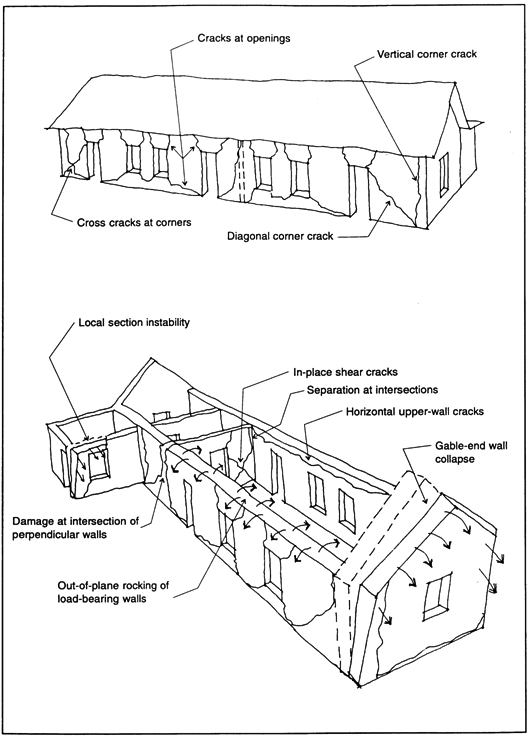SEISMIC STABILIZATION OF HISTORIC ADOBE STRUCTURESWILLIAM S. GINELL, & E. LEROY TOLLES
2 2. THE NATURE OF ADOBE STRUCTURE FAILUREIn adobe wall structures, cracking is almost certain to occur during seismic ground motions when the stresses in the wall exceed the tensile capacity of the adobe material. While the building is undamaged it will perform elastically, but as cracks develop, the dynamic vibrational characteristics undergo significant changes: the fundamental vibration frequency decreases dramatically and the displacements increase by 2 or 3 orders of magnitude. Motion along cracks becomes substantial as cracked surfaces intersect to form independent blocks of material. When the cracks fully develop, each wall becomes an assemblage of broken adobe blocks rather than a monolithic element, and this condition can lead to the collapse of the structure. The primary cause of the most often observed damage is the low tensile strength of the adobe bricks and mortar. Both shear and flexural stresses develop because of the low tensile strength of these materials. Typical failure typologies observed in historic adobe buildings are shown in figure 1. Forces parallel to the plane of the wall (in-plane forces) cause tensile stresses and diagonal cracking. Forces perpendicular to the plane of the wall (out-of-plane forces) cause flexural stresses, cracking, and wall rocking as shown in the long solid wall. Further development of the cracks in the long wall can result in a classic bearing wall failure. The walls typically fall outward, allowing the heavy tile or earthen roofs to collapse, killing occupants trapped inside. The failure of building corners results from a combination of flexural and tensile stresses. Once the corners have failed, the adjacent walls are more likely to fail out-of-plane and overturn. Tensile failure at the junction between perpendicular walls is another common failure mode. Interior partitions are often butted-up to exterior walls with no positive connection between the masonry of the adjoining walls. Gable end wall cracking, collapse, or overturning are the most commonly observed serious damage modes.
Using strength and ductility as fundamental survival criteria, it has been assumed that adobe buildings should not be able to resist the damaging effects of large seismic events. Yet many adobes, although cracked, have retained their stability and have not collapsed catastrophically during earthquakes. Therefore, a retrofitting design approach based on achieving stability, rather than improving strength, should be the most effective method for providing life safety while minimizing damage during moderate to large earthquakes. This design philosophy accepts the fact that although adobe has little material ductility, other characteristics of adobe buildings can be used to develop the needed structural ductility that is important in determining the seismic performance of the building. An important parameter in this regard is the relationship between the adobe wall thickness and the associated height-to-thickness ratio, SL (Bariola 1991). In the context of the work reported here, values of SL associated with estimated seismic effects on adobe walls are given in table 1.
For thin-walled adobe buildings, collapse is imminent once the walls have cracked, and therefore a thin-walled building has little structural ductility. For moderate- to thick-walled adobe buildings, cracks result in the formation of adobe blocks whose relative displacements can become very large, and both in-plane and out-of-plane collapse (overturning) become the principal failure modes. Failure in this sense refers to an adobe wall that cannot support itself or other loads. Thin walls that are not load-bearing are most susceptible to overturning, but moderate to thick load-bearing walls are more stable because displacements are limited by increased interblock friction and by connections to the roof or floor systems. Gable adobe end walls are particularly vulnerable to overturning because SL is usually large and the walls are not load-bearing. However, the challenge that was faced in the design of a stability-based retrofit was not how to prevent cracking (an inevitable consequence of an earthquake that will not necessarily result in structural collapse) but how to minimize the relative displacement of the adobe block wall segments so that overturning and loss of roof support do not occur. |
